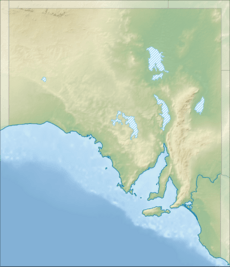Mount Scott Conservation Park facts for kids
Quick facts for kids Mount Scott Conservation ParkSouth Australia |
|
|---|---|
|
IUCN Category Ia (Strict Nature Reserve)
|
|
| Nearest town or city | Kingston SE |
| Established | 9 November 1972 |
| Area | 12.67 km2 (4.9 sq mi) |
| Visitation | 'low' (in 1994) |
| Managing authorities | Department for Environment and Water |
| See also | Protected areas of South Australia |
Mount Scott Conservation Park is a special place in South Australia. It's a protected area where nature is kept safe. This park is found in a spot called Blackford. It's about 23 kilometers (14 miles) east of Kingston SE. You can find it in the beautiful Limestone Coast region of the state.
Contents
What is Mount Scott Conservation Park?
This conservation park sits on old coastal sand dunes. These dunes run from the north-west to the south-east. They are not very tall, reaching a maximum height of about 30 meters (98 feet). A creek that no longer flows, called Reedy Creek, is next to the park's south-western side. The West Avenue Range is on its eastern side.
The soil in the park changes depending on the area. On the slopes of the dunes, you'll find deep sandy soil with limestone rocks. In the lower areas, the soil is more like clay. These low spots can get very wet during rainy times. You can get into the park from its north-west corner using Mount Scott Road. There's also a special track for park staff to use. The park gets its name from a nearby hill called Mount Scott.
Protecting the Park
Mount Scott Conservation Park was officially created on November 9, 1972. This happened under a law called the National Parks and Wildlife Act 1972. This law helps protect important natural places in South Australia. The park is a very strict nature reserve. This means it's a place where nature is protected as much as possible. As of 2012, companies were not allowed to search for oil or gas in the park.
Plants and Animals
In 1994, many different types of plants were found in the park. It also had some special animals.
- The south-western side of the park has flat areas. These areas are mostly covered with tall river red gum trees.
- In the middle of the park, there's a limestone ridge. Here, you can find woodlands of South Australian blue gum and pink gum trees.
- The eastern side of the park has sandier soil. This area is home to mallee vegetation. Mallee plants are a type of eucalyptus that grow as multi-stemmed shrubs.
- In the low, wet areas with chalky soil, you might see South Australian swamp paper-bark and mallee honey-myrtle plants.
Some of the animals seen in the park include:
Visiting the Park
In 1994, not many people visited Mount Scott Conservation Park. Those who did were usually walkers, campers, or people who love studying nature. At that time, there was a picnic and camping area. It was located in the north-east corner of the park, close to where visitors enter.


